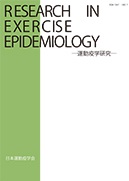Volume 15, Issue 2
Displaying 1-5 of 5 articles from this issue
- |<
- <
- 1
- >
- >|
Preface
-
2013Volume 15Issue 2 Pages 57-60
Published: September 30, 2013
Released on J-STAGE: May 09, 2021
Download PDF (316K)
Review Article
-
2013Volume 15Issue 2 Pages 61-70
Published: September 30, 2013
Released on J-STAGE: May 09, 2021
Download PDF (508K)
Original Article
-
2013Volume 15Issue 2 Pages 71-80
Published: September 30, 2013
Released on J-STAGE: May 09, 2021
Download PDF (490K) -
Associations of perception, attitude, action and belief to power saving with physical activity level2013Volume 15Issue 2 Pages 81-90
Published: September 30, 2013
Released on J-STAGE: May 09, 2021
Download PDF (603K)
Series
-
2013Volume 15Issue 2 Pages 91-100
Published: September 30, 2013
Released on J-STAGE: May 09, 2021
Download PDF (563K)
- |<
- <
- 1
- >
- >|
